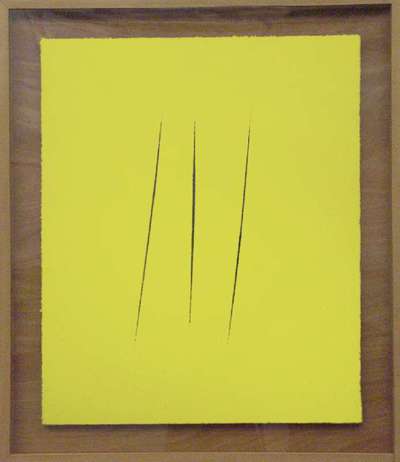Javascript must be enabled to continue!
Spatial Conception
View through Europeana Collections
Early in his career, Fontana, a sculptor’s son, had concentrated solely on sculpture. In 1948, he began puncturing and, later, slicing canvases, creating what he called Concetti spaziali (Spatial Conceptions). Freeing the canvas from its traditional, two-dimensional status, he formulated a new pictorial language, no longer attempting to create an illusion of space but actually creating space. The cuts (tagli), first executed in 1958, exemplify Fontana’s mature work. The surface is pure and monochromatic, but that purity is ruptured by the cuts that allow the void behind the canvas to penetrate the final work. As with the calligraphic strokes of East Asian ink paintings, the precise incisions were premeditated and irreversible. When viewing Fontana’s works, our mind reconstructs the strokes of the knife – a process of visualization that engenders a new aesthetic through destruction. As the artist himself once said, “As a painter working on one of my prepared canvases, I don’t want to make a picture, I want to open up space, to create a new dimension for art” (quoted in Jan van der Marck and Enrico Crispolti, Lucio Fontana, vol. 1 [Brussels, 1974], p. 7).
Title: Spatial Conception
Description:
Early in his career, Fontana, a sculptor’s son, had concentrated solely on sculpture.
In 1948, he began puncturing and, later, slicing canvases, creating what he called Concetti spaziali (Spatial Conceptions).
Freeing the canvas from its traditional, two-dimensional status, he formulated a new pictorial language, no longer attempting to create an illusion of space but actually creating space.
The cuts (tagli), first executed in 1958, exemplify Fontana’s mature work.
The surface is pure and monochromatic, but that purity is ruptured by the cuts that allow the void behind the canvas to penetrate the final work.
As with the calligraphic strokes of East Asian ink paintings, the precise incisions were premeditated and irreversible.
When viewing Fontana’s works, our mind reconstructs the strokes of the knife – a process of visualization that engenders a new aesthetic through destruction.
As the artist himself once said, “As a painter working on one of my prepared canvases, I don’t want to make a picture, I want to open up space, to create a new dimension for art” (quoted in Jan van der Marck and Enrico Crispolti, Lucio Fontana, vol.
1 [Brussels, 1974], p.
7).
Related Results
Spatial Poem No. 2: A Flux Atlas
Spatial Poem No. 2: A Flux Atlas
This is a record of the second of Shiomi's international mail-art events, which began in 1965. Designed by George Maciunas, it is a map, accordion-folded in four panels, documentin...
Spatial Poem No. 4
Spatial Poem No. 4
This edition contains the documentation of Shiomi's "Shadow Event", in which participants were instructed to "project the shadow of the letters S H A D O W of the enclosed film." T...
Tapestry Room from Croome Court
Tapestry Room from Croome Court
Plaster pine mahogany bronze-gilt marble lapis lazuli steel; wool and silk (22-24 warps per inch 9-10 per centimeter)...
Flux Stationery: Foot in Shoe (paper)
Flux Stationery: Foot in Shoe (paper)
Maciunas designed and printed the Flux Stationery for inclusion in "Fluxpack 3", distributed by Multipla in Milan. The stationery was also distributed by Maciunas himself, and by "...
Flux Stationery: Foot in Shoe (envelope)
Flux Stationery: Foot in Shoe (envelope)
Maciunas designed and printed the Flux Stationery for inclusion in "Fluxpack 3", distributed by Multipla in Milan. The stationery was also distributed by Maciunas himself, and by "...
The Young Ladies of Giverny, Sun Effect
The Young Ladies of Giverny, Sun Effect
As a young artist in Paris Monet he was particularly impressed with the work of Courbet and Manet. During the 1860s he painted large-scale, ambitious works in an effort to attain f...
Virgin of the Immaculate Conception
Virgin of the Immaculate Conception
Bronze fire-gilt; polychromy silver...




